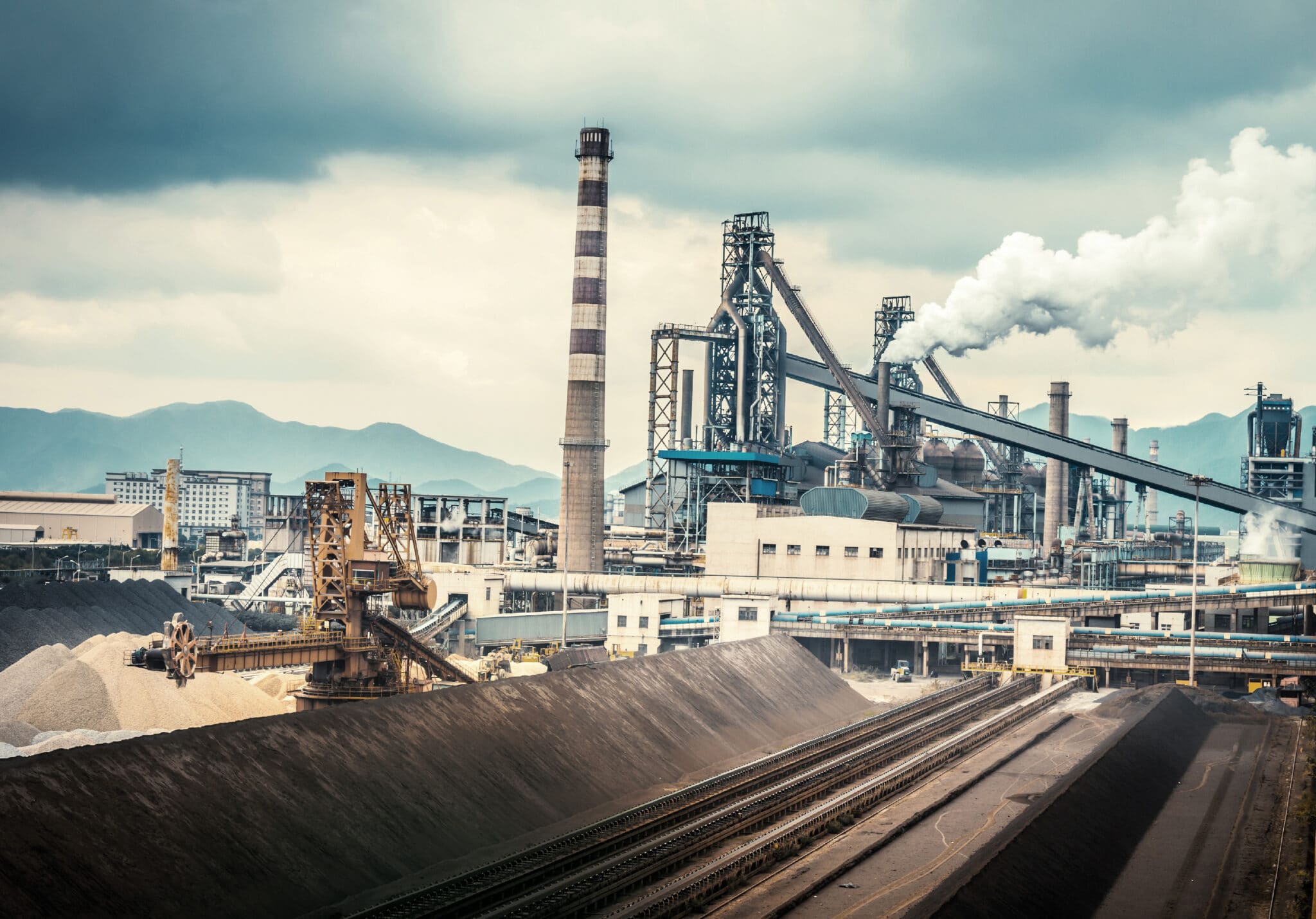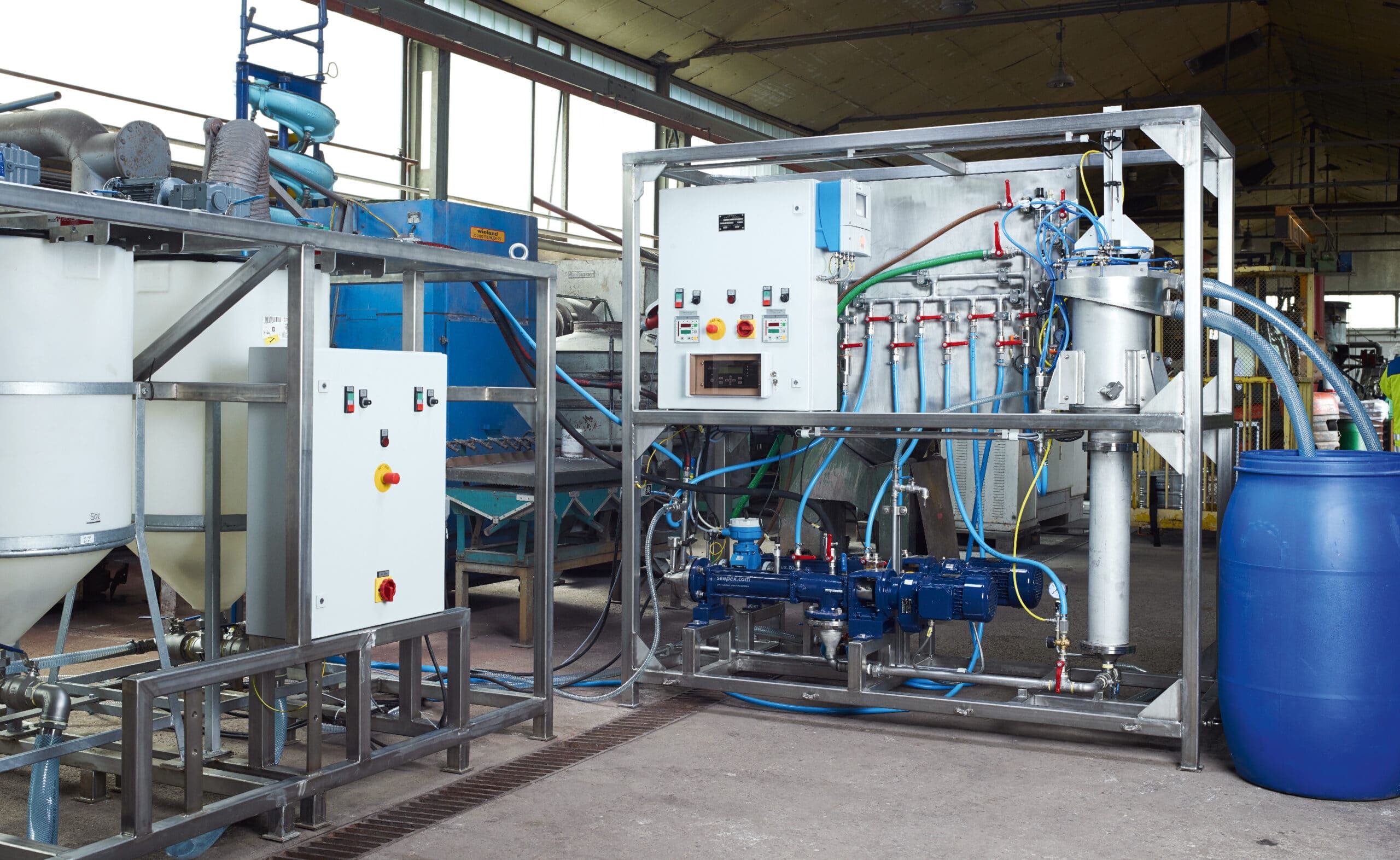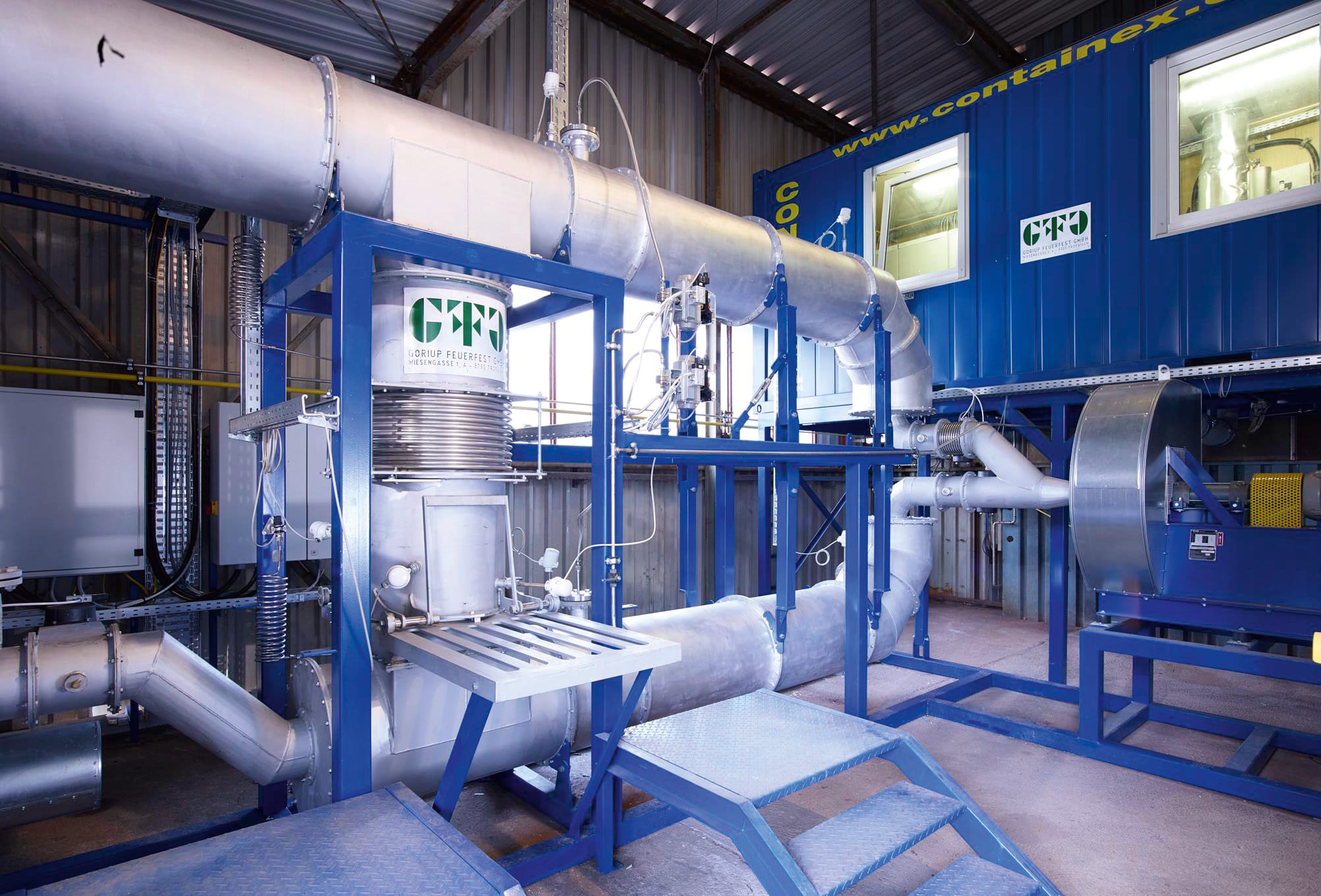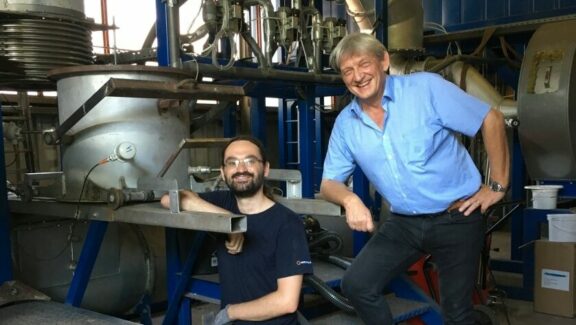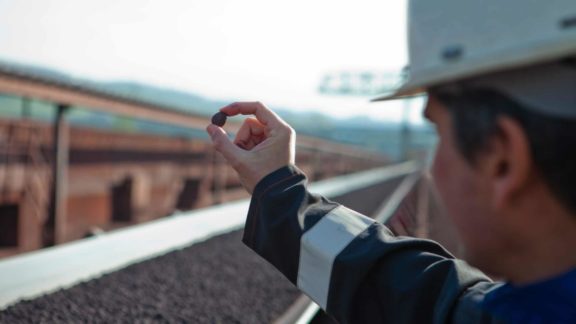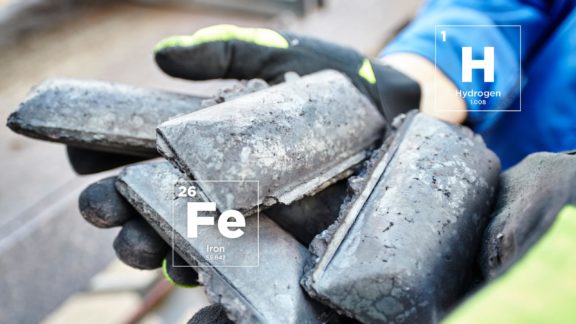This post is also available in: 简体中文 (Chinese (Simplified))
The efficiency of iron and steel production has always been decisive for producers to remain cost-competitive. It can be shown that the properties, cost and quality of iron ore are the most important factors that influence the overall efficiency of the subsequent iron- and steelmaking steps. Improving the quality of iron ore benefits the entire process chain. Primetals Technologies has therefore intensified its efforts and activities in the field of beneficiation to support producers to derive the maximum value from their ore. Practical simulation and calculation tools have been developed to assess the suitability of iron ore, and optimized beneficiation measures are proposed for more efficient iron and steel production.
The market is increasingly calling for detailed analyses and improvements at each step of the iron- and steelmaking production chain. The drivers behind this development are the difficulties in ensuring profitability and the dwindling availability of high-grade raw materials at reasonable prices. In the past, the primary focus was placed on enhancing downstream production processes, however, upstream processes, in particular beneficiation, today offer many opportunities for profitable improvements. By enhancing the quality of lower-grade raw materials through beneficiation, downstream processes also become more viable.
Various production routes are available to transform iron ore into liquid steel, as shown in Figure 1. The selected route depends to a large extent on the quality of the iron ore, energy source and related costs. Assuming that these factors are equivalent for a certain region, the quality and properties of the available iron ore can usually be enhanced by applying the right technology, intensity and sequence of beneficiation steps. In general, iron ore beneficiation is done at the mining site. The concentrated iron ore is subsequently sintered or pelletized, depending on the grain size distribution, before it is charged to an ironmaking plant. In cases where after the initial processing steps the iron ore fractions are of inferior quality (too fine or low iron content), the iron ore quality can be significantly improved by applying additional beneficiation measures. These may include comminution, classification, gravity separation, density separation, magnetic separation and/or flotation.
At grain sizes below 100 µm, impurities such as silica and alumina are separated from the iron ore in a sequence of beneficiation steps, depending on the mineralogy of the iron ore. Removal of impurities from the iron ore is done prior to subsequent processing in pelletizing plants and direct-reduction plants. Otherwise, the impurities will simply pass on to the downstream production steps, resulting in higher energy requirements to melt the increased quantities of slag (where the impurities generally tend to concentrate). This may be in the blast furnace (thermal energy) or in the electric arc furnace (electrical energy). Especially in areas characterized by high costs for power, more attention is thus being focused on the benefits offered by iron ore beneficiation.
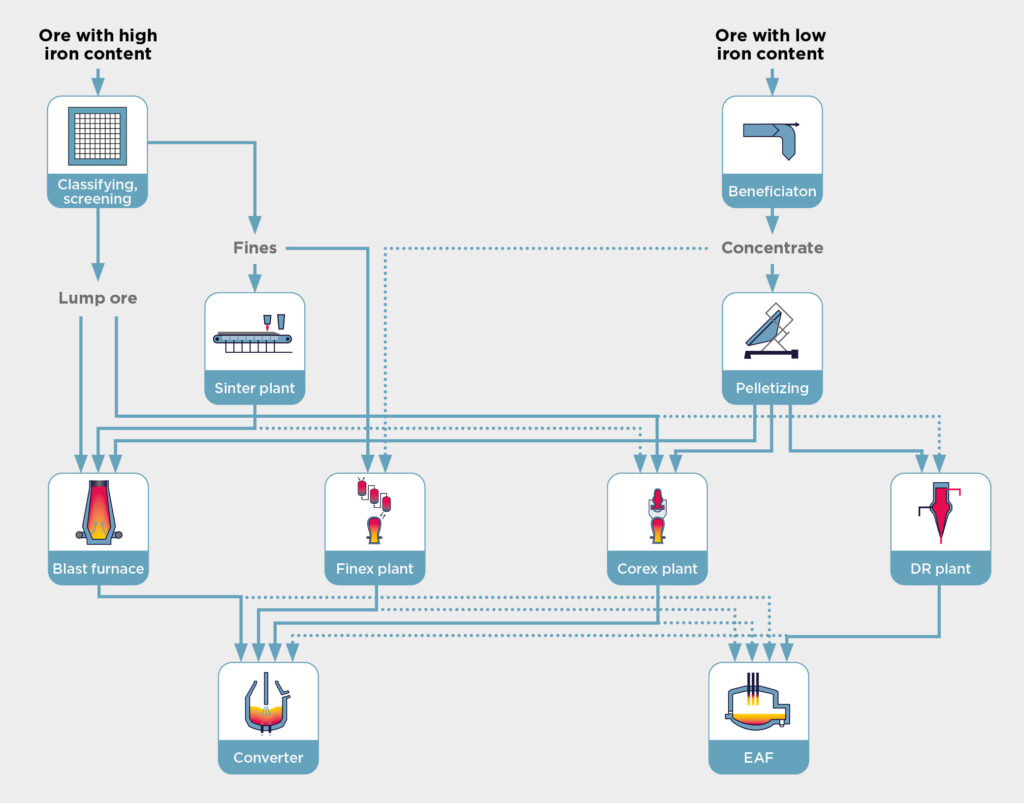
The future is electric
The growing importance of using enhanced iron ores for steelmaking is exemplified by a recent trend in electric steelmaking. Most electric arc furnaces (EAF) are based on the use of scrap. However, with consideration to erratic scrap prices, particularly for high-quality scrap, many producers are considering using direct-reduced iron (DRI) as an additional or as the primary feed material for their EAFs. The DRI ironmaking route is also attracting the attention of many producers who already sell iron ore or pellets on the market and now want to increase the value of their products by selling hot-briquetted iron (HBI) as a merchant good. The use of high-grade ore to make high-grade DR pellets is a prerequisite for the production of high-quality DRI that is hot-compacted to HBI.
Identifying the optimum ore-beneficiation procedures
Primetals Technologies has responded to the challenge of improving the quality of iron ore and has introduced a computer-based model that provides an initial analysis of the suitability of a particular iron ore for use in the steelmaking process. The results of these analyses can be verified in practical tests with in-house testing facilities, or may be conducted elsewhere in the labs of customers, universities and research partners (Figures 2–3).
Testing facilities used by Primetals Technologies include lab- and pilot-scale beneficiation tests, as well as pellet pot and reduction tests. The tests are followed by a selection of the best overall process route, and the required beneficiation steps are defined. The goal is always to identify the most feasible route with consideration to the specific requirements of the customer.
Benefit from beneficiation
Primetals Technologies supports its customers with detailed assessments of available ores and offers solutions to maximize ore value through beneficiation. As a highly experienced full-liner plant builder, Primetals Technologies integrates the complete production route from run-of-mine ore to liquid steel into a single entity with the highest efficiency and lowest-possible processing costs.
Case Study No. 1
Primetals Technologies proposed various upgrading measures to improve the efficiency of the beneficiation process at a Kazakh ironmaking plant. Existing equipment was utilized to the greatest extent possible. Improvement measures included the application of a clever slurry-handling and ore-treatment procedure, implementation of a more effective dewatering and filtering system, and the use of an innovative binding agent that reduced the quantity of required additives to produce ore pellets. These measures allowed the iron content of the iron ore concentrate and the resulting pellets to attain 69.2% and 66.5% respectively. All laboratory, pilot, and pelletizing test work was executed in the labs of Primetals Technologies in Austria.
Case Study No. 2
For an Indian customer with access to an untypical magnetite ore with an exceptionally high sulfur content, a feasible ore-processing route was identified that would allow iron ore pellets to be produced for use in the blast furnace. The study included solution measures for the beneficiation and pelletizing processes in order to reduce the sulfur content in the raw materials from up to 4% down to significantly less than 0.5% in the ore pellets.
The first induration trials conducted in pellet pot tests showed that the ore contains two different sulfur compounds, which are completely combusted at different temperature levels in the pellet bed. Due to the extremely high SO2 load in both offgas ducts (hood exhaust and windbox exhaust), Primetals Technologies adopted a solution that combines thermal pretreatment in an early beneficiation stage to remove the “low-temperature” sulfur with an intelligent tailor-made process-gas routing for a circular traveling grate induration machine to remove “high-temperature” sulfur in a downstream DeSOx plant.

Case Study No. 3
An Egyptian customer contracted Primetals Technologies to conduct a study related to the utilization of local low-grade iron ore for the production of direct-reduction-grade pellets. The ore is available at extremely favorable costs, however, its use for the production of direct-reduced iron (DRI) in a process route that includes beneficiation, pelletizing, DRI production and steelmaking still had to be carefully investigated in terms of technical and economic feasibility.
Ore samples sent to Primetals Technologies initially underwent physical, chemical and mineralogical analyses, which lead to the conclusion that beneficiation is mandatory due to the grain size distribution of the ore, low iron content and the high portion of undesirable elements. Following a series of beneficiation tests, it could be shown that the iron content in the final concentrate of the Egyptian iron ore would be significantly below 58%, which meant that the ore could only be sintered or pelletized for use in blast furnace ironmaking and that it could not be feasibly used in a direct-reduction process route. Furthermore, the exclusive use of local iron ore would have a negative impact on the operation and productivity of the blast furnace and downstream LD (BOF) steelmaking facility due to the unacceptably high percentage of phosphorous and manganese in the ore. Thus, blending of local iron ore concentrates with outside higher-grade iron ore concentrates containing a lower fraction of undesirable elements is required if the local iron ores are to be used.
Case Study No. 4
A Russian steel producer plans to install a pelletizing plant in order to substitute a portion of the sinter smelted in the blast furnaces with pellets. Currently, the beneficiation plant produces a magnetite concentrate that is agglomerated in three older sinter plants, which are no longer capable of fulfilling the product quality requirements and environmental regulations.
Primetals Technologies was requested to determine the achievable pellet quality, the necessary design parameters of the induration machine and the waste gas emission rates based on the produced concentrate. Support was also provided to the customer for predicting the effects of a changing burden composition on blast furnace operation, as well as for feasibly coordinating the reduction in sinter capacity, modified beneficiation procedures and pellet capacity increase.
During the pelletizing pot tests, it could be shown that with minor adaptations in the beneficiation process, a much higher pellet quality can be achieved. Based on the improved pellet quality parameters, the complete production route from beneficiation to hot metal could be visualized in the Integrated Steel Plant Optimization Tool of Primetals Technologies.*
*This tool allows different operational states to be reviewed and evaluated along the entire iron and steel production route, extending from plant construction and installation up to start-up and commissioning. Plant shutdowns as well as various project implementation scenarios can also be depicted.
